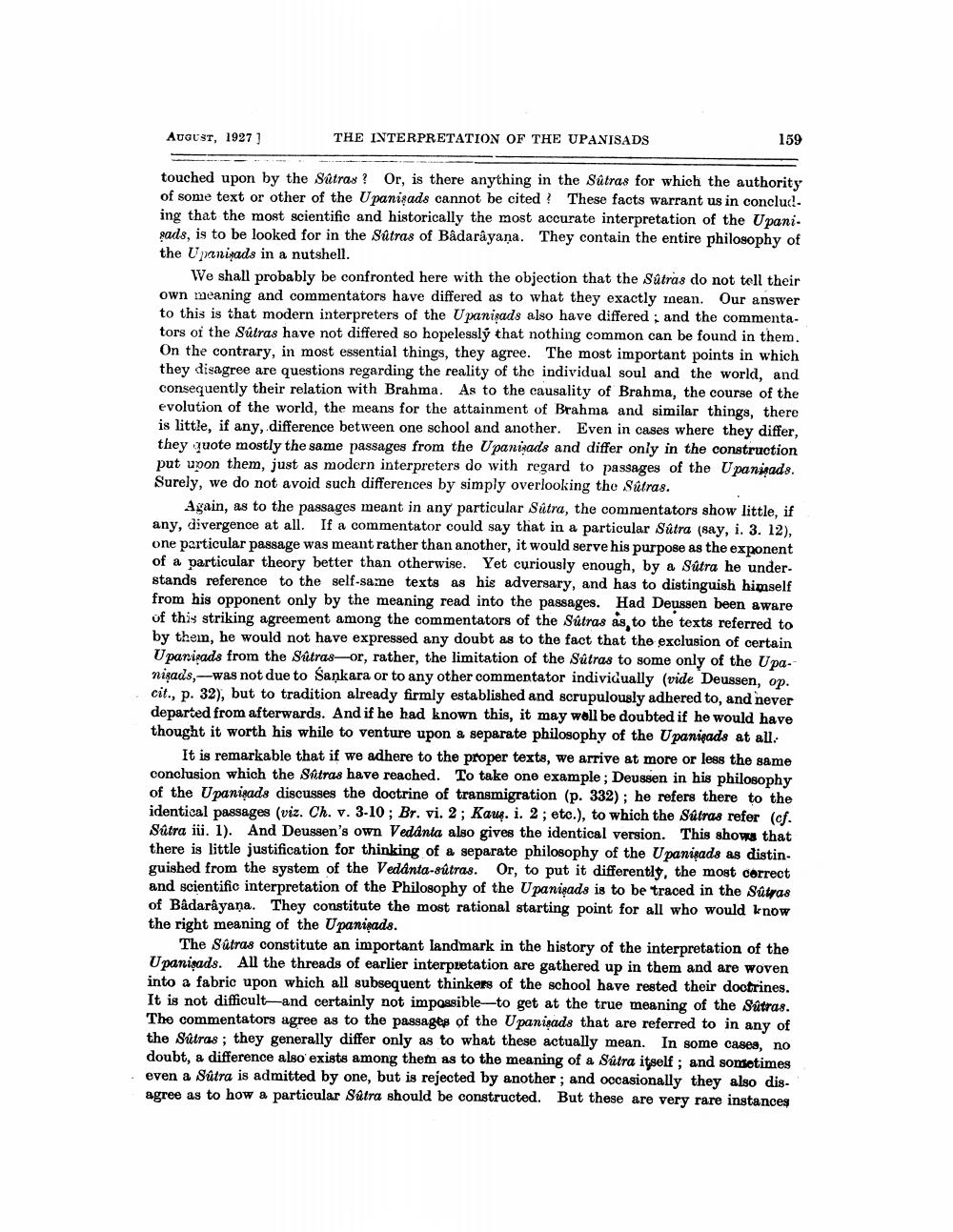________________
AUGUST, 1927)
THE INTERPRETATION OF THE UPANISADS
159
touched upon by the Sútras? Or, is there anything in the Sútras for which the authority of some text or other of the Upanişads cannot be cited? These facts warrant us in conclus! ing that the most scientific and historically the most accurate interpretation of the Upanirads, is to be looked for in the Sutras of Bådarayaņa. They contain the entire philosophy of the Upaniyads in a nutshell.
We shall probably be confronted here with the objection that the Stras do not tell their own meaning and commentators have differed as to what they exactly inean. Our answer to this is that modern interpreters of the Upanişads also have differed ; and the commentators of the Sútras have not differed so hopelessly that nothing common can be found in them. On the contrary, in most essential things, they agree. The most important points in which they disagree are questions regarding the reality of the individual soul and the world, and consequently their relation with Brahma. As to the causality of Brahma, the course of the evolution of the world, the means for the attainment of Brahma and similar things, there is little, if any, difference between one school and another. Even in cases where they differ, they quote mostly the same passages from the Upaniads and differ only in the construction put upon them, just as modern interpreters do with regard to passages of the Upanigads. Surely, we do not avoid such differences by simply overlooking the Satras.
Again, as to the passages meant in any particular Sútra, the commentators show little, if any, divergence at all. If a commentator could say that in a particular Sutra (say, i. 3. 12). one particular passage was meant rather than another, it would serve his purpose as the exponent of a particular theory better than otherwise. Yet curiously enough, by a Sútra he understands reference to the self-same texts as his adversary, and has to distinguish himself from his opponent only by the meaning read into the passages. Had Deussen been aware of this striking agreement among the commentators of the Sútras as, to the texts referred to by them, he would not have expressed any doubt as to the fact that the exclusion of certain Upanigads from the Satras-or, rather, the limitation of the Sútras to some only of the Upanişads,-was not due to Sankara or to any other commentator individually (vide Deussen, op. cit., p. 32), but to tradition already firmly established and scrupulously adhered to, and never departed from afterwards. And if he had known this, it may well be doubted if he would have thought it worth his while to venture upon a separate philosophy of the Upanipads at all.
It is remarkable that if we adhere to the proper texts, we arrive at more or less the same conclusion which the Satras have reached. To take one example ; Deussen in his philosophy of the Upanigads discusses the doctrine of transmigration (p. 332); he refers there to the identical passages (viz. Ch. v. 3-10; Br. vi. 2; Kaus. i. 2; etc.), to which the Sútras refer (cf. Sútra iii. 1). And Deussen's own Vedanta also gives the identical version. This show that there is little justification for thinking of a separate philosophy of the Upanigads as distin. guished from the system of the Vedanta-sútras. Or, to put it differently, the most correct and scientific interpretation of the Philosophy of the Upanigads is to be traced in the Satras of Badarayana. They constitute the most rational starting point for all who would know the right meaning of the Upanigads.
The Sûtras constitute an important landmark in the history of the interpretation of the Upanigads. All the threads of earlier interpretation are gathered up in them and are woven into a fabric upon which all subsequent thinkers of the school have rested their doctrines. It is not difficult and certainly not impossible-to get at the true meaning of the Sútras. The commentators agree as to the passages of the Upanigads that are referred to in any of the Sûtras ; they generally differ only as to what these actually mean. In some cases, no doubt, a difference also exists among them as to the meaning of a Sútra itself; and sometimes even a Sútra is admitted by one, but is rejected by another; and occasionally they also disagree as to how a particular Sútra should be constructed. But these are very rare instances




